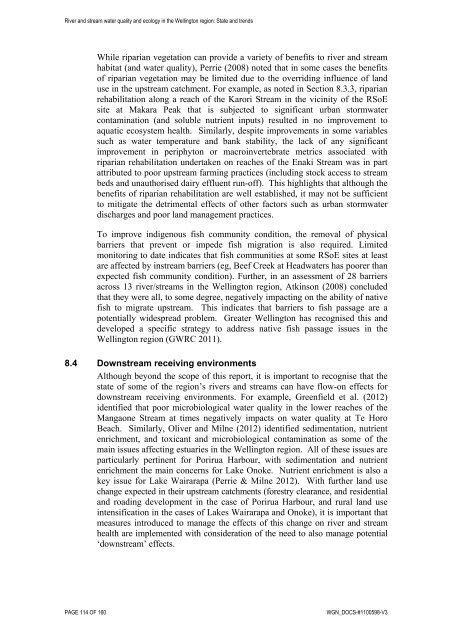River and stream water quality and ecology - Greater Wellington ...
River and stream water quality and ecology - Greater Wellington ...
River and stream water quality and ecology - Greater Wellington ...
Create successful ePaper yourself
Turn your PDF publications into a flip-book with our unique Google optimized e-Paper software.
<strong>River</strong> <strong>and</strong> <strong>stream</strong> <strong>water</strong> <strong>quality</strong> <strong>and</strong> <strong>ecology</strong> in the <strong>Wellington</strong> region: State <strong>and</strong> trends<br />
While riparian vegetation can provide a variety of benefits to river <strong>and</strong> <strong>stream</strong><br />
habitat (<strong>and</strong> <strong>water</strong> <strong>quality</strong>), Perrie (2008) noted that in some cases the benefits<br />
of riparian vegetation may be limited due to the overriding influence of l<strong>and</strong><br />
use in the up<strong>stream</strong> catchment. For example, as noted in Section 8.3.3, riparian<br />
rehabilitation along a reach of the Karori Stream in the vicinity of the RSoE<br />
site at Makara Peak that is subjected to significant urban storm<strong>water</strong><br />
contamination (<strong>and</strong> soluble nutrient inputs) resulted in no improvement to<br />
aquatic ecosystem health. Similarly, despite improvements in some variables<br />
such as <strong>water</strong> temperature <strong>and</strong> bank stability, the lack of any significant<br />
improvement in periphyton or macroinvertebrate metrics associated with<br />
riparian rehabilitation undertaken on reaches of the Enaki Stream was in part<br />
attributed to poor up<strong>stream</strong> farming practices (including stock access to <strong>stream</strong><br />
beds <strong>and</strong> unauthorised dairy effluent run-off). This highlights that although the<br />
benefits of riparian rehabilitation are well established, it may not be sufficient<br />
to mitigate the detrimental effects of other factors such as urban storm<strong>water</strong><br />
discharges <strong>and</strong> poor l<strong>and</strong> management practices.<br />
To improve indigenous fish community condition, the removal of physical<br />
barriers that prevent or impede fish migration is also required. Limited<br />
monitoring to date indicates that fish communities at some RSoE sites at least<br />
are affected by in<strong>stream</strong> barriers (eg, Beef Creek at Head<strong>water</strong>s has poorer than<br />
expected fish community condition). Further, in an assessment of 28 barriers<br />
across 13 river/<strong>stream</strong>s in the <strong>Wellington</strong> region, Atkinson (2008) concluded<br />
that they were all, to some degree, negatively impacting on the ability of native<br />
fish to migrate up<strong>stream</strong>. This indicates that barriers to fish passage are a<br />
potentially widespread problem. <strong>Greater</strong> <strong>Wellington</strong> has recognised this <strong>and</strong><br />
developed a specific strategy to address native fish passage issues in the<br />
<strong>Wellington</strong> region (GWRC 2011).<br />
8.4 Down<strong>stream</strong> receiving environments<br />
Although beyond the scope of this report, it is important to recognise that the<br />
state of some of the region’s rivers <strong>and</strong> <strong>stream</strong>s can have flow-on effects for<br />
down<strong>stream</strong> receiving environments. For example, Greenfield et al. (2012)<br />
identified that poor microbiological <strong>water</strong> <strong>quality</strong> in the lower reaches of the<br />
Mangaone Stream at times negatively impacts on <strong>water</strong> <strong>quality</strong> at Te Horo<br />
Beach. Similarly, Oliver <strong>and</strong> Milne (2012) identified sedimentation, nutrient<br />
enrichment, <strong>and</strong> toxicant <strong>and</strong> microbiological contamination as some of the<br />
main issues affecting estuaries in the <strong>Wellington</strong> region. All of these issues are<br />
particularly pertinent for Porirua Harbour, with sedimentation <strong>and</strong> nutrient<br />
enrichment the main concerns for Lake Onoke. Nutrient enrichment is also a<br />
key issue for Lake Wairarapa (Perrie & Milne 2012). With further l<strong>and</strong> use<br />
change expected in their up<strong>stream</strong> catchments (forestry clearance, <strong>and</strong> residential<br />
<strong>and</strong> roading development in the case of Porirua Harbour, <strong>and</strong> rural l<strong>and</strong> use<br />
intensification in the cases of Lakes Wairarapa <strong>and</strong> Onoke), it is important that<br />
measures introduced to manage the effects of this change on river <strong>and</strong> <strong>stream</strong><br />
health are implemented with consideration of the need to also manage potential<br />
‘down<strong>stream</strong>’ effects.<br />
PAGE 114 OF 160 WGN_DOCS-#1100598-V3
















